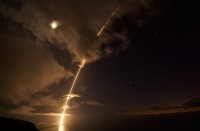
SYDNEY, Australia (AFP) — Australians enjoying a sunny winter morning were shocked by the sight of three Chinese warships steaming into Sydney Harbour Monday, forcing the prime minister to reassure jittery residents.
Amid heightened concern about Beijing’s growing clout and military muscle-flexing, the appearance of a Chinese flagged task group and around 700 sailors came as a surprise.
It also came as Prime Minister Scott Morrison was away on a visit to the Solomon Islands, a key player in the South Pacific that China is hoping to woo away from its recognition of Taiwan.
“It may have been a surprise to others, but it certainly wasn’t a surprise to the government,” Morrison told reporters in the Solomons capital Honiara when asked about the Chinese naval visit. “We have known about that for some time.”
Morrison described the port call as a “reciprocal visit, because Australian naval vessels have visited China”.
“They were returning after a counter drug trafficking operation in the Middle East.”
The vessels appeared to be the Kunlun Shan, an amphibious landing ship; the Luoma Lake, a replenishment ship; and the Xuchang, a modern frigate that is believed to be fitted with surface-to-air and anti-submarine missile systems.
They are scheduled to stay until Friday.
The timing of their visit has been questioned, coinciding with Morrison’s Solomons trip and on the eve of the 30th anniversary of the violent suppression of the Tiananmen demonstrations.
On 4 June 1989 the regime gunned down hundreds of its own citizens and jailed thousands more, after protesters demanded political change and an end to state corruption.
The arrival of the ships also comes just days after it was revealed that a Chinese warship had recently confronted an Australian vessel in the South China Sea, and Australian helicopter pilots had been targeted with lasers.
“I think any reading into timing could be subject to a bit of overanalysis,” said Morrison.
Since coming to power, President Xi Jinping has invested heavily in the People’s Liberation Army and navy in a bid to project Chinese influence across the Pacific and beyond.
“Chinese naval visits to Australia have more typically been a lone frigate, not a task group with an amphibious assault ship and 700 personnel,” tweeted Rory Medcalf, head of the National Security College at Australian National University.
“Sydney is hardly a convenient stopover on their way home from the Gulf of Aden. What’s the story here?”
“This looks like a serious show of presence in the South Pacific.”
China’s aim of developing a “blue-water Navy” has been greeted warily in Canberra, which has worked to counter Beijing’s growing presence at home and in its South Pacific back yard.
During Morrison’s trip to the Solomons on Monday he announced Aus$250 million (US$173 million) in aid to retain Australian influence on the strategically important island chain.
© Agence France-Presse







